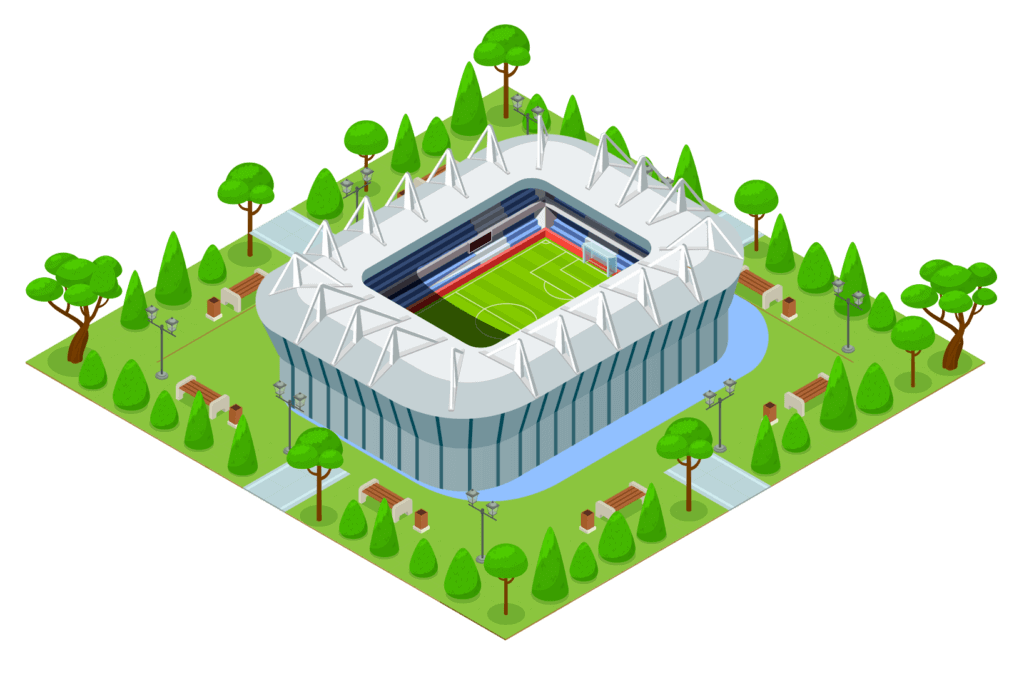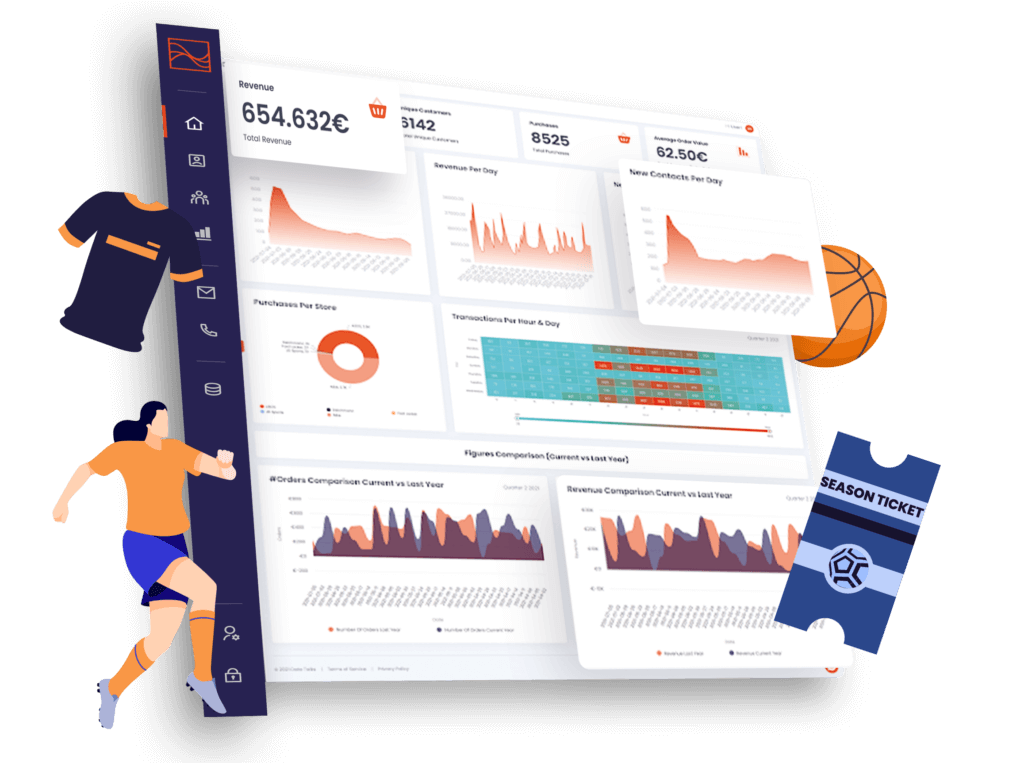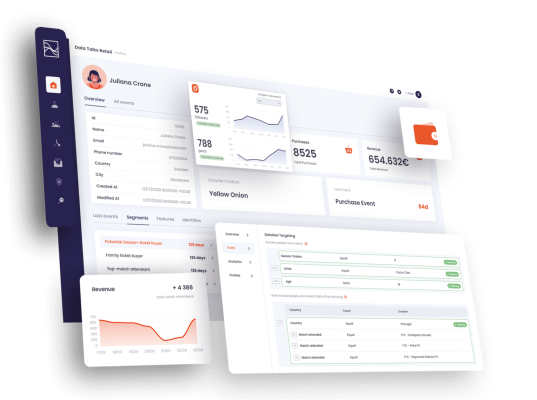
Winter is upon us. And if you have been able to avoid thinking about energy bills and the energy crisis, that’s about to come to an end. Because the sad truth is the whole of Europe is at a crossroads. Energy bills are skyrocketing. Not just for households and private individuals. But for businesses across the board. The sports industry is no exception.
So in today’s blog post we will discuss:

The current conversation around energy usage and energy bills

What you can do to navigate this and do your part for the environment

How to not let your energy bills affect your revenue
Before we dive right in...
Subscribe to our blog today to ensure that you never miss valuable posts such as this one. We are passionate about helping sports organizations deliver a world-class fan experience, because better fan experience means better business. So why not use this opportunity to the fullest?

The current conversation around energy usage and energy bills
Consumer energy bills are 35% higher than they were last year. This trend is set to continue for the next foreseeable future. This, unfortunately, means that people will continue to be affected. Sports clubs will continue to be affected as well. For larger sporting organizations and clubs, it might be easier to offset the increased costs by increasing season ticket and merchandise prices. Additionally, if they are able to keep ticket sales steady and consistent, the impact might not be as big. But this will need to be a concerted and organized effort. Smaller clubs and many semi-professional, community-based, grassroots, and amateur clubs, on the other hand, will have a tougher time.
But let’s not forget that it is not just sports clubs that are affected by the current situation. The fans and supporters are affected too. They also have higher bills to contend with. So the solution is not as simple as just increasing ticket and merchandise prices. One could even argue against doing that. Is it really fair to increase prices to matches when supporters’ are faced with the prospect of ridiculously high energy bills? But that is a topic for another day.
Towards climate neutrality

This conversation, however, is not just about the price of energy. It’s also part of a much bigger conversation, namely; climate neutrality. Climate neutrality, in simple terms, is about reducing greenhouse gas emissions as much as possible. It additionally means compensating for any remaining emissions. We know that the sports industry has its role to play in this as well.
Some of the ways that sports clubs contribute to higher emissions include:
- Transport of supporters to reach the club’s games
- Electricity and heating of the facilities during games, for example
- Transport of teams and supporters to away games
How sports organizations use electricity and heating facilities is a big contributor to both climate neutrality and energy bills. Maybe, in a way, the energy crisis is a wake-up call for the whole world and not just Europe. Why do I say that? When there was no crisis to contend with, we didn’t really think much about our energy usage. We reserved this for the eco-zealots, for lack of a better word. But now, we are being forced to examine our own usage. If not because we are concerned about the environment, for the concern over energy prices.
What you can do to navigate this and do your part for the environment
Problems are always the perfect backdrop to change. As such, there are many opportunities for sports organizations, be it leagues, clubs, or teams, to change the way they use energy. In the short term, this will help reduce the cost of energy. But in the long run, this will help sports organizations do their part for the environment.
So let’s briefly look at the opportunities that different sports clubs can seize in order to cut down energy costs, while simultaneously contributing to climate neutrality.

Switching winter kick-offs to lunchtime
It gets darker quicker in the wintertime. Meaning that floodlights will be needed for the game. So some clubs are considering lunchtime as a better time for kick-offs as this will keep their energy bills low. I think that such a practice should be considered as a permanent solution for the sake of the environment too. Of course, there are practicalities to consider such as how many fans would actually make it to lunchtime matches and other factors. But I believe that looking deeper into scheduling and incentivizing the new changes will easily solve this issue. Remember the fans and supporters are affected as well and they care for the environment too. So they would not need that much convincing.
Using renewable energy
Football clubs in the highest leagues are some of the wealthiest organizations in the world. So it’s shocking really that we have not seen that much investment in renewable energy from such clubs. A great club leading the way in this and setting a perfect example is FC Freiburg, a club in the Bundesliga in Germany. The club’s new Europa-Park-Stadion stadium has a total of 6,200 solar panels on the roof that generate a peak output of around 2.4 megawatts. The only stadium in the world that can top this is that of Istanbul club Galatasaray, which has 10,400 solar panels that produce 4.2 megawatts.
And what was the reason FC Freiburg chose to invest in solar energy? To “make itself independent of price fluctuations”. Renewable energy helps keep energy bills down. So this is an area more clubs should look into investing in especially. Especially because of the short-term benefit of keeping energy costs down. But also for the long-term benefit of climate neutrality.
RELATED BLOG POST:

Sports and society: how sports organizations can play their part here >>
Other ways to cut down energy bills while being more climate neutral
There is no one-size-fits-all when it comes to this topic really. And this is because of several reasons.
- Some sports clubs don’t own their stadiums so their hands are tied, so to speak. It would be up to their landlords to choose to, for instance, invest in LED floodlights instead of Halogen ones. The former is more expensive to purchase. But, since they are cheaper to operate and have a longer service life, they work out cheaper. But in this instance, the club would have to convince the landlord. Of course, it is worth the try but it might not always be easy to convince landlords.
- Not all clubs have the money to invest in renewable energy. This is especially true for smaller clubs. But that is why the EFL considering having winter kick-off at lunchtime is a great way to mitigate the situation. So smaller clubs will have to think outside the box in order to save energy bills. But I know that this is easier said than done.
- Banding together is probably one of the most effective ways of tackling the energy crisis. Certain governments of certain countries are subsidizing bills. But maybe bigger leagues such as the English Premier League can work with smaller leagues to support with upfront investment. This might sound like a controversial idea, but do you know how well this can be marketed to get even more fans and sponsorships? Once again, thinking outside the box is a necessity.

Join a community of people who care about making an impact in sports here >>
How to not let your energy bills affect your revenue
This is the elephant in the room, right? It’s all good and well trying to save the environment, but some clubs are struggling to survive. So their priority is not the environment, but themselves. Say what you will about this kind of thinking but it is a reality. I won’t argue whether it’s right or wrong. But I will be remiss if I didn’t acknowledge that this is a huge issue.
There are two apparent issues for me here. The first is that bigger clubs will probably fare better than smaller clubs. They can wade out of the crisis with some concerted effort, that is. As I mentioned in the introduction, bigger clubs might offset their energy bills with slight price increases, keeping ticket purchases steady, etc. But the second issue is that for smaller clubs, this might be the straw that breaks the camel’s back. That is, they might never recover from having to cover the cost of rising energy bills.
So then, I think that we should look at the two issues separately.
Solutions for bigger clubs
Let’s talk about the idea of offsetting high energy bills with price increases. This sounds like a logical solution. But I would argue that it is not necessarily the smartest unless it is the last resort. That’s because it’s not just sports clubs that are affected by the energy crisis in the EU. It’s also private individuals. They also have higher energy bills. Meaning that they have a higher cost of living and less disposable income. Would you want them to pay more for your tickets on top of that?
Well, this depends indeed. If you are using a sports CDP the next section will make sense for you. If you are not, why not request a demo and then come back to finish reading the blog post so you can get a better understanding of how you can use it to strategically offset your high energy bills?
This is how I suggest you go about increasing your ticket prices to offset your energy bills.


Find out which supporters to target
In the CDP, you can identify VIP supporters and high-spenders, mid-spenders, and low-spenders. You do this through the segmentation functionality of the CDP. Hopefully, it’s obvious at this point that you should not target low-spenders with any price increases. Mid-spenders, you would have to do this under special circumstances.

Find out the offers to target the supporters with
Different supporters buy different types of tickets, no matter if they are a high-spender, mid-spender, or otherwise. So the key here is to find out what each supporter wants from you. For example, let’s say you have identified a VIP supporter, who has bought season tickets for the last 5 seasons. They also buy merchandise regularly. They, however, hardly ever buy individual tickets. Increasing the price for individual tickets for this supporter will not make a difference. But because you know that they always buy season tickets, you are more confident that if you increased the price of season tickets, they would not be too deterred. They are still highly likely to buy.
So this is how you should approach your price increases. Don’t just do a one size fits all. Look at your different types of supporters, and their purchase behavior, and then tailor your prices to them.

Send out a message your supporters will appreciate
This can make or break your campaign, so you need to get this right. Charging differently to different segments can upset some people. That’s why it’s important to make sure that you send out a message that your supporter will appreciate. This is what this can look like:
- If you are charging more – explain your reasoning to the supporter. Appeal to their emotional side to get them to understand why you are doing this. But also make it worth their while. Íncentivize this by offering them unlimited access to exclusive content on your app, if you have one. Start an ambassador program or “special members program” where you acknowledge them for doing their part to help make sports accessible to all. The CDP will help you understand which supporters to target with which message so that you get this right.
- If you are charging the same price – communicate this to your supporters. Tell them that you are keeping prices the same for them because you want them to be able to attend your games during this tough time. Communicate your empathy and compassion. And then encourage them to buy tickets so that you can continue to keep the prices down. Target your mid to low-spenders with this in your single tickets category for example.
These are just but two examples. You might need to do it differently depending on the insights you get from the analytics framework in your CDP. But being strategic will help you keep your energy bills down without upsetting your supporters by giving them the impression that you want to make money at their expense.

To see how this would look in action, explore the Data Talks CDP demo >>
Solutions for smaller clubs
The bad news: bigger clubs have it easier. They have the resources to invest in solutions to reduce their energy bills. Not only that but they have stronger brands. So they don’t need to do too much in the way of trying to encourage hard-strapped supporters to attend their games. You on the other hand have your work cut out for you. The good news is that you can still sell more tickets, negotiate sponsorship agreements of higher value and sell more matchday merchandise. But it gets even better. The great news is that although this might seem like a steep uphill climb, it does not need to be. Why?
Because the CDP will help you get the job done. How? Let’s have a look.
The challenges you have to overcome

To make this example even easier to understand, let’s face and identify the challenges that you have to overcome. The context is, you are trying to sell more tickets to supporters who are contending with high energy bills. And as a result, have less money to spend on buying tickets to your games. But likewise, you also have your own energy bills to contend with. So, you need your supporters to buy tickets. This is at the very top of your priority list. Naturally, time is of the essence. You need to sell as many tickets as possible as quickly as possible.
Here are some challenges you will have to overcome to sell more tickets (read to the very end):
- You have to have your supporters’ contact information so that you can target them better. That’s because the chances of a supporter buying a ticket when they receive an email from you are much higher than if you just post on social media that they should buy tickets.
- Knowing the type of tickets your supporters have previously bought will help you target them with the right ticket offerings. It’s a waste of your time, energy, effort, money, and human resources when you ask a supporter to buy a season ticket when they have only ever bought a single ticket to your game in all of their 10 years of being a fan. So the challenge is to understand your supporters’ buying behavior.
- You also have to know which message to send to your supporters right? Does your supporter want a discount? Or would they want to know what other things they can buy from you? For example, you might have a supporter who always buys merchandise at every game they attend. They would want to know what deals you have going, right?
This sounds like a lot of work right? And normally, it would be. But …
How the sports CDP can help you
The sports CDP does all of that work for you. What you would have needed a whole week to accomplish, you can do in a matter of hours. Saving you time and energy while delivering crazy results. And you need crazy results now more than ever right? This is what a CDP will help you do:
- Grow your contact database, continuously. Meaning that you will have a way of contacting all your supporters. This is guaranteed to produce more results for you than any of your current strategies. There are no two ways about it. If your contact database is not clean and up-to-date, you are missing out on a chance to make a lot of money.
- Collect supporter data with contact information and merge it with your sales data. This will give you a clearer picture of what your supporters tend to buy from you.
- Find out which supporter segments you should target with your ticketing campaigns. Targeting your supporters with the wrong ticketing campaigns does not only not produce results, but it might become annoying. Leading to your supporters unsubscribing from your emailing list. This is not something you can afford at this crucial point in time.
- Send out relevant ticket offerings to those segments in a way that your supporters will really appreciate. And watch as your stadium matches start to get more and more packed.
Doing any of this work manually is a nightmare and requires a lot of time and effort. But with the CDP, it’s seamless and easy. Request a demo today to see how this can work for you.

Key takeaways
So much information so little time. Let me summarize the blog post for you.
There is a current energy crisis in the EU. But you know this already because it is reflected in your energy bills. With winter almost upon us, this is only set to increase. Meaning that you will have to find solutions for cutting down costs. Such solutions include – switching to lunch time-kick offs and thinking outside the box, investing in renewable energy or energy-saving equipment such as LED lights. However, there is no one-size-fits-all solution because different clubs have different circumstances and resources. For example, some clubs don’t own their stadiums so they can’t decide on which equipment to use.
Because of the energy crisis, it is important now more than ever, for sports clubs to increase their revenue. This will help them offset the rising energy bills. Different clubs will have to go about increasing their revenue in different ways. For bigger clubs, it is important to not just increase ticket prices to offset the high energy cost. They have to understand, who to target with which ticket prices and how to communicate this in a way that their supporters will appreciate.
For bigger clubs
It is important to not just increase ticket prices as a way of offsetting the high cost of energy. They have to understand, who to target with which ticket prices and how to communicate this in a way that their supporters will appreciate. This is something that a sports CDP can help all big clubs accomplish.
For smaller clubs
Selling more tickets becomes an even higher priority because this is the only way that smaller clubs can offset the higher cost of energy. Once again, the CDP can help smaller clubs with this.
The energy crisis should not be the reason that any club loses revenue. So, make sure you take the appropriate steps today to ensure that it does not become your reality. Today might look a bit dire, but the future can still be bright.
